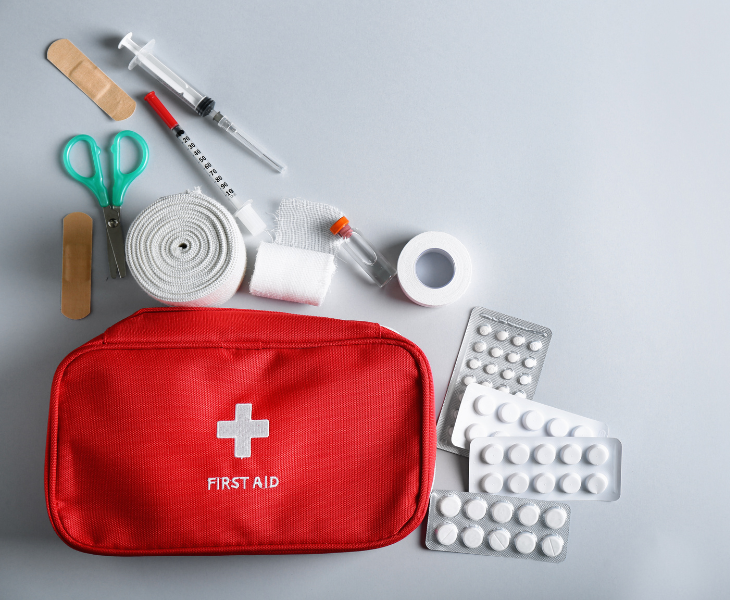Safety and wellbeing in the workplace are paramount. One critical aspect of ensuring a safe working environment is being prepared for medical emergencies. No matter the size or nature of the business, having the right first aid equipment on hand is crucial.
1. Comprehensive First Aid Kits

A well-stocked first aid kit is the cornerstone of workplace safety. These kits should be tailored to the specific needs
and risks associated with the workplace, but there are essential items that every first aid kit should include.
Basic Items
Every first aid kit should include a variety of bandages, adhesive tape, gauze pads, antiseptic wipes, and adhesive
bandages. These items are essential for treating minor cuts, scrapes, and burns. It’s also important to have scissors and tweezers on hand for cutting bandages or removing foreign objects from wounds.
Wound Care Supplies
Sterile dressings, eye pads, and wound cleaning solutions like saline or antiseptic wipes are important for treating more significant injuries. Including triangular bandages can also be useful for creating slings or binding larger wounds.
Cold Packs
Cold packs are excellent for treating sprains, strains, or bruises. They help reduce swelling and pain in the immediate aftermath of an injury.
CPR Masks
Having a CPR mask in the kit ensures safe and effective mouth-to-mouth resuscitation. This piece of equipment is especially important in environments where employees may not be trained in advanced first aid techniques.
2. Eye Wash and Burn Treatment

Every first aid kit should include eye wash to treat eye injuries, especially in environments where there is a risk of chemicals or debris entering the eyes. Burn treatment supplies, such as burn cream or gel, should also be included to provide immediate relief and prevent infection in case of burns.
3. Automated External Defibrillators

Cardiac emergencies are one of the most serious medical incidents that can occur in the workplace. Having an Automated External Defibrillator (AED) onsite can be life-saving. AEDs are portable devices that deliver an electric shock to the heart, restoring normal rhythm during sudden cardiac arrest.
Accessibility and Training
AEDs should be placed in easily accessible locations, and employees should be trained on how to use them. Although AEDs are designed to be user-friendly with clear instructions, having trained personnel can ensure the device is used quickly and correctly.
Regular Maintenance
It’s essential to conduct regular checks on AEDs to ensure they’re functioning correctly. This includes checking the battery life, ensuring the pads are not expired, and that the device is ready for immediate use.
4. Splints and Bandages
Rigid and Flexible Splints
Both rigid and flexible splints should be available to accommodate different types of injuries. Rigid splints provide firm support, while flexible splints can be moulded to fit the injured area more comfortably.
Elastic Bandages
These are essential for securing splints or dressings in place and providing support to sprains or strains. Elastic bandages also help reduce swelling and limit movement, aiding in the recovery process.
5. Antiseptics and Disinfectants

Keeping wounds clean and preventing infection is a top priority in first aid. Antiseptic solutions and disinfectants are
necessary for cleaning wounds before applying dressings.
Alcohol-Free Solutions
It’s important to include alcohol-free antiseptics in the first aid kit, as these are less likely to cause irritation, especially on sensitive skin or open wounds.
Multiple Applications
Antiseptic wipes, sprays, and creams should all be included to cover different types of injuries and areas of the body.
Hand Sanitiser
Although not technically first aid, hand sanitiser is essential for limiting the spread of germs and limiting the risk of
infection before and after first aid and wound care.
6. Regular Training and Drills

While not a physical piece of equipment, regular training is a critical component of an effective first aid response. Employees should be trained in basic first aid procedures, CPR, and the use of AEDs. Regular drills can also help ensure that everyone knows what to do in an emergency.
Certification and Recertification
Employees should be encouraged to obtain first aid and CPR certification, with regular recertification to keep their skills up to date.
Emergency Response Plan
Every workplace should have a clear emergency response plan that includes procedures for medical emergencies. This plan should be regularly reviewed and practiced to ensure everyone is prepared.
Ensuring that a workplace is equipped with the necessary first aid supplies is not just about meeting regulatory requirements; it’s about protecting the health and safety of everyone there. A well-stocked first aid kit, an accessible AED, and trained employees can make all the difference in an emergency.


